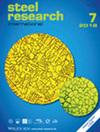不同含硅量的熔融高硅电工钢的密度、表面张力和粘度
IF 1.9
3区 材料科学
Q2 METALLURGY & METALLURGICAL ENGINEERING
引用次数: 0
摘要
在不同温度下测量了各种液态电工钢的密度、表面张力和粘度,其硅含量在 3 至 6 质量%之间。密度和表面张力是用最大气泡压力法测定的,而粘度则是用振动手指粘度计和振动坩埚粘度计进行比较研究的。研究结果与文献中已知的模型进行了比较。在此基础上,钢的密度 [ρ] = kg m-3 和表面张力 [σ] = N m-1 可以用公式描述为温度 [θ] = °C 和硅含量 [Si] = 质量%的函数:, .文献中缺乏电工钢高温热物理性能的实验数据。这再次强调了本研究的新颖性和重要性,因为所测定的热物理性质对于广泛的应用至关重要。例如,在通过雾化生产用于增材制造的金属粉末时,它们对于精确调整粉末特性至关重要。研究结果对炼钢本身也很重要,因为可以更好地确定耐火材料的腐蚀行为。本文章由计算机程序翻译,如有差异,请以英文原文为准。
Densities, Surface Tensions, and Viscosities of Molten High‐Silicon Electrical Steels with Different Silicon Contents
Density, surface tension, and viscosity of various liquid electrical steels are measured at different temperatures, varying in their silicon content between 3 and 6 mass%. Density and surface tension are determined using the maximum bubble pressure method, while viscosity is investigated comparatively using a vibrating finger viscometer and an oscillating crucible viscometer. The results are compared with models known from the literature. Based on this, the density of the steel [ρ ] = kg m−3 and the surface tension [σ ] = N m−1 can be described as a function of temperature [θ ] = °C and silicon content [Si] = mass% using the equations: , . There is a lack of experimental data in the literature for high‐temperature thermophysical properties for electrical steels. This underlines once again the novelty and significance of this study, as the determined thermophysical properties are essential for a wide range of applications. For instance, they are crucial in the production of metallic powders for additive manufacturing by atomization to adjust the properties of the powders precisely. The findings are also important for steelmaking itself, as the corrosion behavior of refractory material can be better determined.
求助全文
通过发布文献求助,成功后即可免费获取论文全文。
去求助
来源期刊

steel research international
工程技术-冶金工程
CiteScore
3.30
自引率
18.20%
发文量
319
审稿时长
1.9 months
期刊介绍:
steel research international is a journal providing a forum for the publication of high-quality manuscripts in areas ranging from process metallurgy and metal forming to materials engineering as well as process control and testing. The emphasis is on steel and on materials involved in steelmaking and the processing of steel, such as refractories and slags.
steel research international welcomes manuscripts describing basic scientific research as well as industrial research. The journal received a further increased, record-high Impact Factor of 1.522 (2018 Journal Impact Factor, Journal Citation Reports (Clarivate Analytics, 2019)).
The journal was formerly well known as "Archiv für das Eisenhüttenwesen" and "steel research"; with effect from January 1, 2006, the former "Scandinavian Journal of Metallurgy" merged with Steel Research International.
Hot Topics:
-Steels for Automotive Applications
-High-strength Steels
-Sustainable steelmaking
-Interstitially Alloyed Steels
-Electromagnetic Processing of Metals
-High Speed Forming
 求助内容:
求助内容: 应助结果提醒方式:
应助结果提醒方式:


